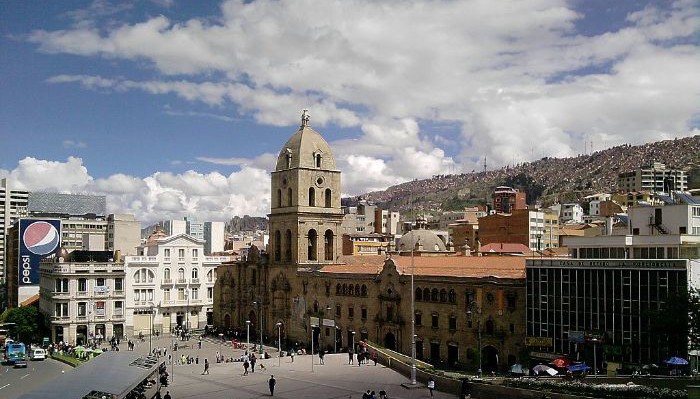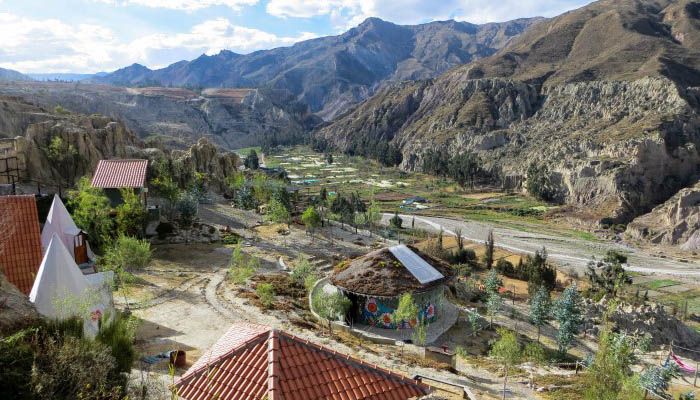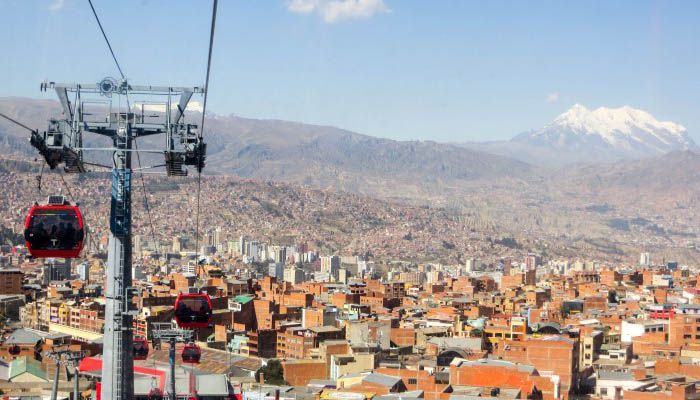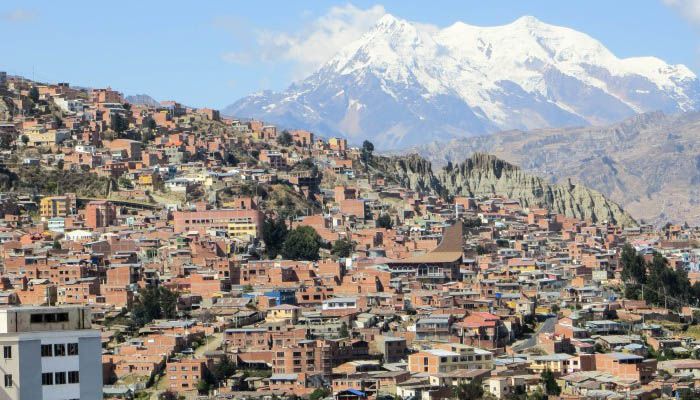Is La Paz for less realistic?
Welcome to the first post in my new feature Cities For Less which showcases tips and tricks from travellers around the globe on how to visit their beloved cities for less money. The idea is to feature a different place every time and give you an individual perspective on ways to save money in that city starting with some fabulous tips from Steph for visiting La Paz for less.
This is a unique city, high in the Andes but are the prices as high as the altitude?
Before, we find out, let me introduce you to the lovely Steph Dyson.
Introducing Steph
Steph writes about travelling adventurously and volunteering meaningfully on her website, Worldly Adventurer.
In 2014, she left her job as an English teacher in the UK to travel the world. So far, she’s volunteered and lived for eleven months in Bolivia and five months in Peru, working with a number of education charities. She plans to continue exploring South America and writing about her adventures, as well as offering honest advice for others looking to volunteer. Feel free to hook up with her on Facebook.
Let’s hear what she has to say about Bolivia’s capital, La Paz.
My Story
La Paz is a fascinating, culturally-rich city set in the altiplano or highland areas of Bolivia. Living costs here are very affordable, making La Paz the ideal destination for a budget break in South America.
What makes La Paz such a fascinating city to visit, is the way that it so strongly divides opinions. Many come here, take one look at the snake-like roads swollen with bumper-to-bumper traffic and close their eyes to the stunning natural formation of the city, the vibrancy of the locals’ clothing, the lingering scents of the street food as it winds through the crowds and the bold yet compelling chaos of the markets.
La Paz is not a clean, quiet nor relaxing metropolis. It is a lively, Latin American city, whose history, and proud preservation of indigenous culture pumps powerfully through every artery. I spent six weeks volunteering and living on the outskirts of La Paz, travelling in to explore the city at weekends.
After just a few weeks, I fell in love. Truly. Madly. Deeply. I enjoyed pausing on the steps in Plaza San Francisco to watch the performances take place, or wandering leisurely through El Mercado de Brujas – The Witches’ Market – to admire the herbal medicines curing anything from chickenpox to unrequited love.

La Paz – and Bolivia in general – is certainly not a place for anyone unwilling to be confronted by the shock of a radically different culture, but for those arriving with an open mind – willing to accept this city, warts and all – La Paz will deliver an incredible experience.
For visitors looking to immerse themselves in the rich culture of this historic city, yet looking for an affordable travel experience, La Paz is the destination to visit. While a weekend spent here is barely enough time to scrape the surface, it will definitely allow a window into the fascinating culture and quirky nature of life in this city.
Information Section
While the altitude certainly takes some getting used to (at 4,100m at its highest point, it takes the crown as the highest administrative capital in the world), La Paz will impress with its affordable costs, ranking it one of the cheapest destinations in the whole of South America.
While flights here will set you back (and for this alone, I would recommend spending a good few weeks in Bolivia), you’ll find that accommodation, meals and activities will have you wondering exactly how you’ve got so many Bolivianos left over at the end of your trip.
As a rule of thumb, you should very easily be living comfortably on no more than 200bs/£20 per day per person, making La Paz an unmissable city for a budget break.
Accommodation
Accommodation in Bolivia is available at rock-bottom prices, and a good deal can be found by using Booking.com to search for hotels in the area. I would strong recommend Muzungu Hostel which is in an excellent location a few blocks from Plaza San Francisco, has private rooms, hot showers, WiFi, a decent included breakfast and, unlike most hostels in the city, does not focus on partying until dawn.
It is very affordable for those seeking a budget break, with rooms costing around 160bs/£16 per night for two people.
If you fancy getting out of the city for a few days and recovering from the altitude, a stunning location to relax – think hammocks, a hot tub and incredible views – is at Colibri Camping. A five-star rated campsite offering ‘glamping’ in tepees or their luxurious A-frame cabin, all with stunning views across La Valle de las Flores (The Valley of Flowers).

Its owners will go out of their way to make your stay comfortable, and can recommend activities to do in the surrounding area. Costs from 200bs/£20 per night for two people. They also have a fully equipped kitchen and decent WiFi.
Anne: Oh man, how awesome does this place look?
Steph: (Disclaimer – This is where I volunteered during my stay in La Paz, but it’s for this reason I can unreservedly recommend the campsite as a wonderful place to stay)
Getting There
The closest airport is El Alto International Airport, eight miles from the city centre. It is reachable via secure taxi service from the airport for around 60bs/£6 or the bus labelled “aeropuerto” which leaves from the right-hand side of the carpark as you leave the terminal, or it can be flagged down on El Prado in the other direction.
Flights are cheapest from London directly to La Paz, just be aware that you are flying directly into over 4,000m of altitude and you will feel the lack of oxygen when you get off your plane!
Given the difficulties that altitude can cause, it’s best to speak to your doctor before flying to organise a prescription for anti-altitude sickness tablets. As it is very difficult to predict who will be affected (and it is not dependent upon age nor state of health) these tablets are one of the best ways to prevent you from being affected by this unfortunate – and potentially life-threatening – illness.
For your first few days in the city, it’s advised to drink plenty of water, take it easy (put off visiting some of the viewpoints until you feel better acclimatised) and avoid drinking alcohol.

Getting Around
Public transport takes the form of minibuses of different sizes – known locally as “trufis”. Traffic in La Paz is crazy and unreliable – but that’s all part of the experience. Local transport will set you back only a few bolivianos per trip, but can be difficult to navigate unless you speak some Spanish, so ask for help from your hotel front desk.
If you’re up for the adventure, it’s fun seeing the city the way the locals do: from the packed windows of their public transport. (Anne: I totally agree Steph, as one of my favourite things to do when travelling is hop on the local buses!)
Most tourists opt to use taxis to get around the city, as these shouldn’t cost most than between 5-10bs (50p-£1), although make sure you always confirm the price is in bolivianos (not USD) and be sure to ask your hotel to ring you a taxi.
Taxis taken from the street in La Paz are notoriously dangerous so avoid them at all costs.
Food and Drink
The irony about food in Bolivia is that this country is definitely not known for its cuisine, and most of the acclaimed restaurants that you’ll find in La Paz are offering international cuisine, rather than local dishes. However, for local people, the culture of South American lunchtime revolves around the food markets, where workers spend an hour eating a two course meal from one of the tiny hole-in-the-wall restaurants.
For an affordable lunch, check out the Mercado Lanza, just off Plaza San Francisco: a multi-floored building with numerous lunchtime restaurants on the top floor. Head here if you want to dine cheaply, elbow-to-elbow with locals, while paying between 8-15bs (80p-£1.50) for a two-course almuerzo (lunch).
You’ll start with a soup such as chairo (deep-friend potato, corn and dried meat), and the segundo might be the delicious saice (minced beef with a spicy sauce, accompanied by rice or pasta). Try a glass of chicha morada (a red corn drink) to accompany your meal, or even buy a drink in a bag to take away!
When eating at the markets, remember to choose your restaurant carefully to avoid any nasty side-effects from badly-cooked food: those swarming with locals (including women and children) are always the best bet.
If you want to check out some of La Paz’s other food offerings, get yourself a delicious, cheap pizza, from Mozzarella Pizza on Avenida Illampu. Prices here range from 20-50bs (£2-£5) depending on the size of your pizza.
Pacena La Saltena on Calle Loayza is renowned for their traditional salteñas (the beef or chicken filled pastries that are typical of South America but particularly delicious here in Bolivia), likely costing up to 50p.
You’ll also find some great cafes and restaurants in the two most vibrant parts of the city: Sopacachi and Zona Sur. Although neither has much to offer in terms of beautiful sights nor interesting historic buildings, if you’re after a decent, but still budget-priced meal, these should be top of your list.
Things To Do
Some of La Paz’s finest attractions do require you to head up high to marvel at the incredible landscape of the city. Pioneering the highest city cable cars in the world, La Paz is useful connected by El Teleferico, which is perfect for tourists wanting to cheaply explore the city.

Currently offering three different lines, the best choice if you want to admire the views of the city is to take the red line from the former railway station on Avenida Perú up to the final stop, 16 de Julio. You’ll find some good views from the upstairs of the building which houses the cable car stop, and the trip should cost you around 30p each way.
From here, you can visit Mercado 16 de Julio, a market held every Thursday and Sunday. Right up in El Alto, this sprawling shopper’s dream is a delightful introduction to the eccentricity of South American markets (think food, second-hand goods, livestock and vehicle-parts to name but a few of the offerings here).
You’ll also have a chance to appreciate how indigenous customs – particularly in the form of the brightly-coloured textiles you’ll find being worn by Bolivian women, and the Aymaran language that you’ll hear being spoken – are still proudly maintained. Just be aware of pick-pocketing and keep a good eye on your things at all times.
Founded in 1548 by the Spanish conquistadores, La Paz has its fair amount of history and culture spanning its indigenous to colonial, to modern-day heritage. The best way to explore it is through a £2 tour with Red Cap Walking Tours (available daily from 11am and 2pm from Plaza San Pedro) who’ll guide you around the most unmissable sites: The Witches’ Market, Plaza Murillo (the scene of a civil uprising back in the early ‘00s), and one of La Paz’s sprawling food markets, amongst others.
There are also a few museums which you should definitely visit to admire Bolivia’s rich, cultural history. Check out the Museo de Etnografia y Folklore on Calle Ingavi (15bs/£1.50) for beautifully hand-crafted fabrics and an introduction to Bolivian weaving. The Museo de Istrumentos Musicales on Calle Jaen (5bs/50p) is another worthy destination: small but crammed full of musical instruments from all over the globe, some of which you can even have a go on.
A guided tour around La Inglesia de San Francisco, with powerful, religious paintings, stunning architecture and impressive views across the city from the roof, should cost around 15bs/£1.50. Even just admiring the church’s façade from the Plaza de San Francisco is worth it, and will give you a chance to embrace the frenetic bustle of La Paz at its busiest and admire the performances that often take place on the main steps of the plaza.
Your Best Splurge
One of La Paz’s finely guarded secrets is the restaurant Gustu. Established in 2012 by Claus Meyer – founder of globally acclaimed restaurant, Norma – Gustu is a restaurant seeking to destroy all previously held conceptions of Bolivian food. Using only local ingredients, you can try a seven course tasting menu for around 600bs/£60 including drinks pairings. There’s also a glass-fronted kitchen and chef’s table, meaning you can get even closer to the action.
What makes this restaurant even more incredible is its focus upon improving life chances for youth in the city: all of its chefs are trained in cooking schools in El Alto (the poorest part of the city) and the best are selected to work in the restaurant itself. When we visited, the oldest chef in the kitchen was a mere 26 years old.
If you get chatting to the maître d’, you might even get a chance to explore the kitchens – including the laboratory downstairs where the chefs are given free rein to trial new recipes. There’s also a bar upstairs where you relax post-meal; if you’ve got any space to fit in another drink!
The Witches Market
Anne: Thanks Steph. The city really does sound amazing. I am totally intrigued by the idea of the Witches Market. Can you tell me more?
Steph: The Witches Market gets its name from the stalls run by “witches” (you can get your fortune told there or buy all sorts of potions and powders to cure every ailment, or even buy dried lama foetuses to bless your house – yum!).
It really is an incredible street and is still such an important part of Bolivian culture – people genuinely still visit the witches when they are ill or want help with their business or to get good fortune. You actually find them in markets in every city, I guess the one in La Paz is just the most famous!
Anne: That sounds really amazing! I definitely feel that I want to visit this city more now thanks to Steph’s write up. Given I start feeling the altitude at heights around half that though, I definitely think I should head to see the doctor first. Doesn’t it look incredible though?

Anne: So there you have it, some awesome tips from Steph.
To finish up, here’s a few final top tips for me on getting the most from your travels generally.
Top Travel Hacks in any city for less
- Book hotels with Hotels.com for one free stay after every ten stays (click through from the Top Cashback store to multiply your earnings rate).
- Alternatively you can book with Booking.com which is also available through the Top Cashback store.
- If you have a credit card, check to see if there are any dining offers you can use in conjunction with the card
So now it is over to you guys.
Have Your Say
Have you visited La Paz? Do you have any top tips for others visiting the city? Feel free to share in the comments box below.
Join hundreds of other subscribers to receive our weekly email with all our posts. Never miss out!
Photo Credits: Steph Dyson unless stated
Disclaimer: Some of the links in this post are affiliate links from which I earn a small commission should you purchase after clicking through. These commissions help to cover the costs of running the site and I’m incredibly grateful if you use these but you are under no obligation.
 From Miles to Smiles Stylish travel for professionals seeking luxury at affordable prices
From Miles to Smiles Stylish travel for professionals seeking luxury at affordable prices
